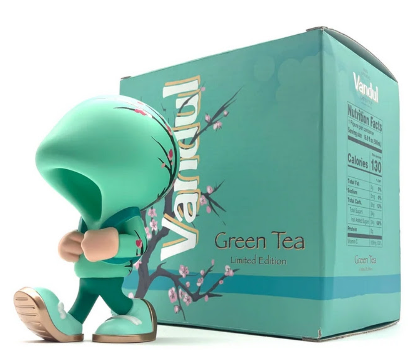
Flowers & Plants
-

Vandul Green Tea Walk Resin Art Toy by Vandul
Green Tea Walk Art Toy by Vandul Limited Edition Resin Sculpture Collectible Artwork by Pop Street Artist. 2023 Limited Edition Art Toys Artwork Size 3x7 New In Box Stamped/Printed Painted Theme of the Arizona Green Tea Drink Can Logo of Flowering Tree. Exploring the Fusion of Street Pop Art & Graffiti Artwork in Modern Collectibles The contemporary art scene has been vibrantly enhanced by the introduction of art toys, particularly those steeped in the ethos of Street Pop Art and graffiti Artwork. A striking example of this cultural synergy is the "Green Tea Walk Art Toy by Vandul Limited Edition Resin Sculpture." This 2023 collectible is not just an object of visual delight but also a representation of the convergence of street art sensibilities and the collectible culture that is rising in popularity. Standing at an impressive 3x7 inches, this artwork is presented new in the box, showcasing its mint condition to collectors and enthusiasts alike. The ingenuity of Vandul, a noted pop street artist, is encapsulated in the limited edition resin sculpture, which reflects a distinct aesthetic drawn from the urban landscape. The figure, characterized by its exaggerated features and thoughtful color palette, epitomizes the playfulness and edginess that are hallmarks of Vandul's work. The sculpture's design is a commentary on the commercialization of art and the commodification of natural elements, as suggested by the green tea theme. This piece embodies the artist's critical eye and creative spirit, rendered three-dimensional. Each art toy comes stamped or printed with authentication marks, ensuring its uniqueness and value as a collectible artwork. The packaging is a part of the artistic expression, with designs that resonate with Vandul's signature style. This style often features elements borrowed from graffiti art, such as bold lines, vibrant colors, and iconic motifs. The fusion of these elements in the toy's design positions it as a coveted item for collectors who value the intersection of art and the urban environment. The Significance of Art Toys in the Landscape of Modern Art Art toys, like the Green Tea Walk Art Toy by Vandul, occupy a unique niche in modern art. They are a physical testament to the creativity and subversive energy that fuels the Street Pop Art and graffiti Artwork movement. These items are more than mere playthings; they are a medium through which artists can reach a wider audience, transcending the traditional gallery walls. Vandul's work with this piece indicates a more significant trend where artists use everyday objects as canvases for expression, bringing art into people's daily lives. The popularity of art toys also signals a shift in how art is consumed and appreciated. No longer confined to the elite spaces of art auctions and high-brow exhibitions, art is becoming more accessible, and collectible art toys are a testament to this democratization. They allow individuals to own a piece of an artist's vision, making personal and intimate connections with the work possible. The limited edition nature of such pieces adds an element of exclusivity and desirability, creating a niche market that is both culturally relevant and commercially viable. Vandul's Green Tea Walk Art Toy is particularly significant as it represents a snapshot of the current zeitgeist. It captures the playful yet poignant commentary on contemporary culture and its intersection with consumerism, often explored in Street Pop Art and graffiti Artwork. The limited edition status of the art toy ensures its value as a collectible, while its aesthetic appeal makes it an attractive display piece that sparks conversation and reflection. The art toy culture is expanding the boundaries of what art can be. It challenges preconceived notions of art's form and function, and in doing so, it invites a new audience to engage with artistic expression. Vandul's Green Tea Walk Art Toy is a prime example of this evolution, a collectible that is as much a piece of art as a statement, a reflection of its time, and a playful nod to the future of artistic expression.
$353.00


